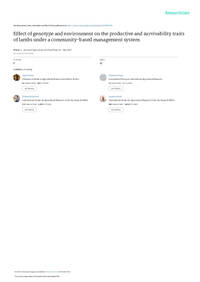Effect of genotype and environment on the productive and survivability traits of lambs under a community-based management system

Authors:
The aim of this study was to evaluate the growth and survival of local and Dorper crossbred lambs managed under a community-based management system, using data collected between 2012 and 2021. The fixed effects considered were breed, location, sex, type of birth, parity, season, and year of birth. The results revealed that Dorper crossbred lambs consistently weighed and gained more than local lambs (p<0.0001) at all ages and that environmental factors such as location, sex, type of birth, parity, season, and year of birth had considerable influence on most growth traits at all ages. The mean birth weight of local, low-grade, and high-grade Dorper crossbred lambs were 2.12 ± 0.04, 2.94 ± 0.03, and 3.08 ± 0.03 kg, respectively. The corresponding pre-weaning daily gain was 89.12 ± 1.85, 112.16 ± 1.38, and 117.98 ± 1.71 g/day, respectively. The post-weaning body weight gain at 90-180 days for the same groups was 32.6 ± 2.16, 46.85 ± 1.62, and 45.93 ± 1.98 g/day, respectively. Dorper crossbred lambs exhibited a bodyweight advantage of up to 45%, 31%, 34%, and 28% over local lambs at birth, 3, 6, and 12 months of age, respectively. Lambs born in the dry season had the lowest weaning (p<0.0001) and six-month (p = 0.0098) weight compared to those born in the rainy seasons. Lamb genotype didn’t have a significant influence on the survival of lambs at all ages, but most environmental factors influenced survivability. Lambs born to ewes in their 5th parity and above had a mortality risk of 0.51 times higher than those born to ewes in their 1st to 4th parity at the age of 6- months. Year of lambing affected lamb pre-weaning (χ2 = 0.0003) and post-weaning (χ2 = 0.0001) survival. Compared to the base year 2021, lambs born in 2017 and 2018 had a higher risk of mortality at 6-month (10.1 and 15.9 times, respectively) than those born in 2021. Season of birth also significantly (χ2 <0.001) affected lamb survivability, with lambs born in the dry season, having a higher mortality risk at weaning (0.46 times) and yearling (0.66 times). Lambs with a birth weight of 2 kg and below had a 2.3 times higher survival risk at 6-months compared to lambs born with 3 kg and above. In conclusion, Dorper crossbred lambs can be considered to improve lamb growth performance and produce fast-growing lambs. However, the study recommends further research to validate the crossbreeding program (considering the influential production environment, research on supplementation for lambs in the dry-season, adjusting the mating season, and the economic feasibility of crossbreeding are suggested).
